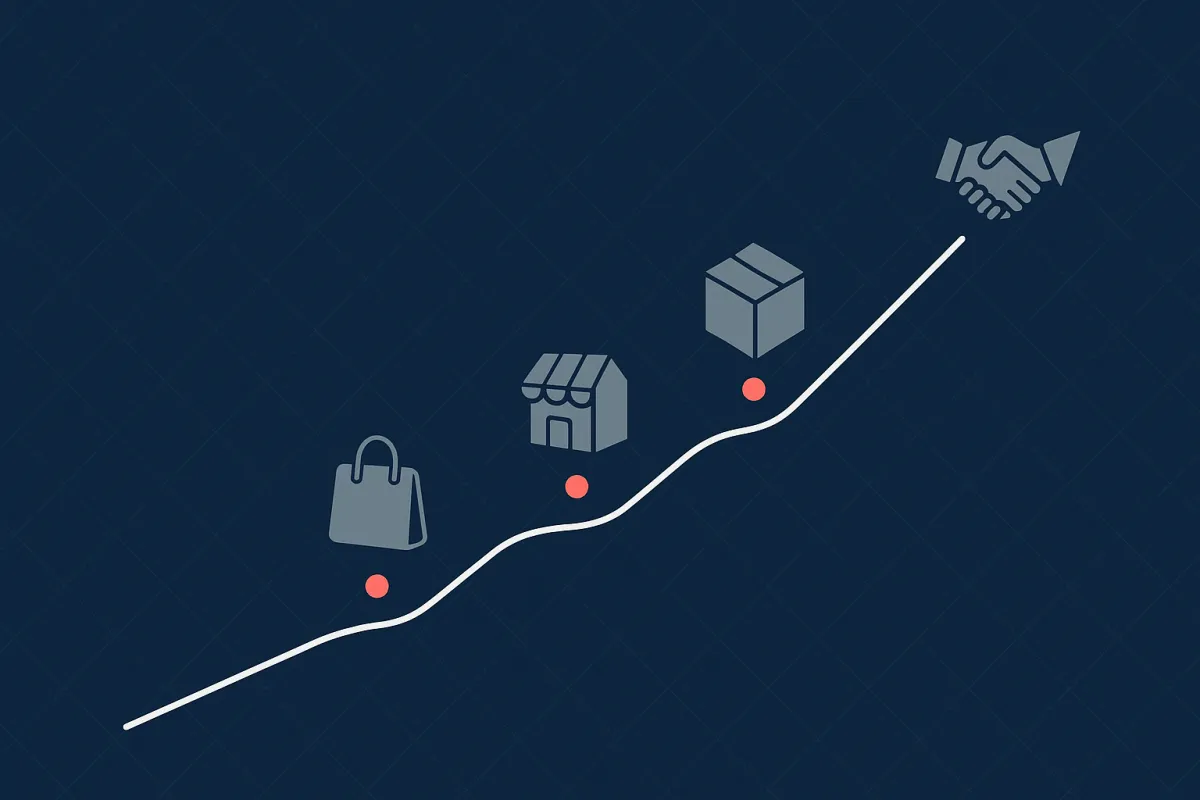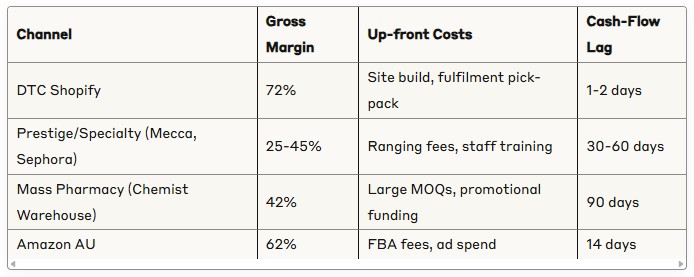
Choose the Right Sales Channels for Your Beauty Brand—And Play to Your Strengths
Jess thought landing Mecca would be a dream—until she saw her gross margin drop from 72% to 29% overnight. The prestigious placement she'd worked eighteen months to secure was suddenly bleeding cash faster than her DTC site during a flash sale. Between the wholesale pricing, ranging fees, staff training requirements, and 60-day payment terms, her "big break" was breaking her business.
Sound familiar? Here's the truth: choosing sales channels for your beauty brand isn't just about prestige or volume—it's about margin math and founder fit. In 10 minutes with the Channel × Margin Matrix she spotted the leak—and fixed it by restructuring her channel mix to protect profitability while still scaling.
The Brutal Reality of Beauty Brand Margin Math
Before we dive into strategy, let's ground ourselves in the numbers that actually matter. Most beauty founders obsess over top-line revenue while their margins quietly erode. Here's what really happens to your money across different channels:

But here's what most founders miss: gross margin is just the starting point. Your true margin follows this formula:
True Margin = Gross Margin - (TACOS + Discounts + Demo Costs)
Let me break this down with a real example. When you sell a $50 serum through DTC, you might keep $36 (72%). But factor in your 25% ad spend (TACOS), 10% new customer discount, and suddenly you're at 37% true margin. Still healthy, but half what you thought.
Mecca or David Jones? That same serum wholesales for $25, leaving you $13.75 after their 25-45% take. Subtract staff training costs, gratis product, and marketing co-op fees, and you might net 20% if you're lucky.
Chemist Warehouse is even more brutal. Between their aggressive margin requirements, promotional funding expectations, and payment terms that stretch to 90 days, you'll need serious working capital just to stay afloat.
The Founder Time & Skill Audit Nobody Talks About
Channel success isn't only capital—it's calendar. Every channel demands different skills and time investments from you as the founder. Before choosing where to sell, you need an honest assessment of where you naturally excel.
Here's the heat map exercise I run with every client:

The magic happens when you see the pattern. Scores of 4 or higher on both Skill and Enjoyment? That's your unfair advantage—start there.
If you light up doing creative and marketing but operations makes you want to hide under your desk, DTC might be your sweet spot—you can outsource fulfilment but own the brand experience. Love negotiating and building relationships? Retail could be your game, despite the margin hit.
Hate everything except product development? Partner up or stay small and profitable through selective DTC until you can hire out the rest.
Now let's pair that self-insight with market realities.
The 2025 Beauty Channel Landscape: What's Actually Working
The Australian beauty industry landscape has shifted dramatically. Here's what's happening right now across channels:

DTC/Shopify:
Pros: Highest margins, complete brand control, immediate cash flow, customer data ownership
Cons: Expensive customer acquisition (CAC averaging $45-65), requires constant marketing innovation
Prestige/Specialty Retail (Mecca, Sephora, David Jones):
Pros: Instant credibility, educated staff, marketing support, sampling programs
Cons: Significant margin compression, slow payment, high minimum orders, limited control
Pharmacy (Priceline, Chemist Warehouse):
Pros: Massive foot traffic, health-conscious positioning, promotional reach
Cons: Aggressive pricing pressure, high promotional costs, complex trading terms
Mass Retail (Coles, Woolworths, Big W):
Pros: Mainstream accessibility, massive volume potential
Cons: Lowest margins, highest operational complexity, brutal ranging reviews
Amazon Australia:
Pros: Growing customer base, FBA handles logistics, relatively quick payment
Cons: Price transparency issues, limited brand building, increasing competition
Recent data shows Australian pharmacy beauty grew 11% year-over-year in 2024, while DTC beauty grew 27% but from a smaller base. The winners? Brands playing in multiple channels strategically.
The Sales Channel × Margin Matrix: Your Strategic Framework
Here's where strategy meets reality. I've developed this matrix after analysing hundreds of beauty brands over 20 years:
Y-Axis: Gross Margin % (low to high)
X-Axis: Scale Potential (unit volume)

The Four Quadrants:
Bottom Left (Low Margin, Low Scale): Avoid unless strategic
Example: Small health food stores, local pharmacies
Only works if you're testing or have local advantage
Top Left (High Margin, Low Scale): Lifestyle businesses
Example: Pure DTC with organic growth only
Perfect if you want control and steady profit
Bottom Right (Low Margin, High Scale): Volume play
Example: Chemist Warehouse, Coles/Woolworths
Requires serious capital and operational excellence
Top Right (High Margin, High Scale): The sweet spot
Example: DTC + selective prestige retail
Strategic pharmacy partnerships with margin protection
[Download the editable Channel × Margin Matrix PDF here]
Real Brands, Real Pivots: 90-Day Channel Transformations
Let me show you how this plays out in practice:

Each of these brands discovered their channel-founder fit through testing, not theory. Drunk Elephant's founder Tiffany Masterson realised she could protect margins by keeping certain SKUs DTC-exclusive while using retail for discovery.
Frank Body, the Melbourne coffee scrub phenomenon, built their brand on Instagram but knew they needed retail to scale. By keeping their limited editions and bundles DTC-exclusive while putting core products in Mecca, they maintained healthy margins while accessing new customers.
The Ordinary took a different approach—they opened their own stores in key locations while being selective about retail partners, avoiding the race-to-the-bottom pricing that kills many brands.
The lesson? Your perfect channel mix aligns profitability with your personal capacity.
Combining Matrix + Audit: Your 5-Step Implementation Plan
Here's exactly how to use these tools together:

Plot your current channels on the margin/scale matrix
Cross-reference with your skill audit—mark any mismatches in red
Identify one test channel that better fits your strengths
Run a 90-day pilot with a single success metric
Scale or stop based on data, not dreams
Remember: every channel pivot should improve either margin or founder happiness. Ideally both.
The CAC Reality Check Most Founders Skip
Here's the equation that determines if a channel actually works:
Blended CAC must be ≤ 25% of Gross Profit
Let me show you two examples:
DTC Skincare Brand:
Average order: $85
Gross margin: 72% = $61.20 gross profit
Maximum sustainable CAC: $15.30
Actual CAC: $52
Verdict: Losing money on every order
Priceline Hair Care Brand:
Average order: $35
Gross margin: 50% = $17.50 gross profit
Maximum sustainable CAC: $4.38
Actual CAC via co-op marketing: $3.20
Verdict: Profitable with volume
The synergy secret? Use high-margin channels to fund customer acquisition, then migrate them to more operationally efficient channels for repeat purchases.
Your Next 90 Days: From Analysis to Action
Stop overthinking. Here's your channel optimisation sprint:

Weeks 1-2: Audit Reality
Complete margin analysis by channel
Fill out founder skill/enjoyment audit
Plot current position on matrix
Weeks 3-6: Test Smartly
If DTC: Launch small batch (limit to 5% of forecast revenue)
If Retail: Approach 3 independent pharmacies before Priceline
If Marketplace: Start with Catch or Amazon AU with hero SKU only
Weeks 7-9: Optimise Relentlessly
DTC: Get TACOS below 25%
Retail: Negotiate terms or walk
Marketplace: TACOS must stay under 12%
Weeks 10-12: Decision Time
Re-run your audits with real data
Choose: scale what's working or optimise what's not
Never do both simultaneously
Ready to Stress-Test Your Channel Strategy?
Most beauty founders guess their way through channel selection and pay for it in burned capital and burnout. You're smarter than that.
The Channel × Margin Matrix combined with your Founder Audit gives you something powerful: clarity. You'll know exactly which channels align with your strengths while protecting your margins.
Over 160 beauty brand founders have downloaded these tools in the last 60 days. They're seeing an average margin improvement of 11% within 90 days of implementation.

Want to go deeper? Book a Growth Strategy Session and I'll personally review your channel mix and show you the hidden profit leaks most founders miss.
Because here's what I know after 20 years and ten 8-figure exits: the right channel strategy isn't about following trends or chasing prestige placements. It's about building a business that serves your customers, respects your margins, and doesn't destroy your soul in the process.
The beauty industry is brutal enough. Your channel strategy shouldn't make it worse.
P.S. Still trying to make Chemist Warehouse work with 35% margins? Let's talk before you sign that trading terms agreement. Sometimes the best deal is the one you don't make.